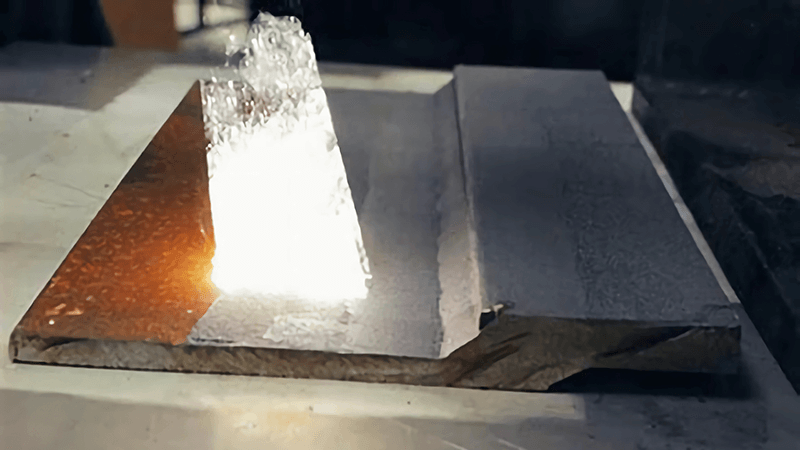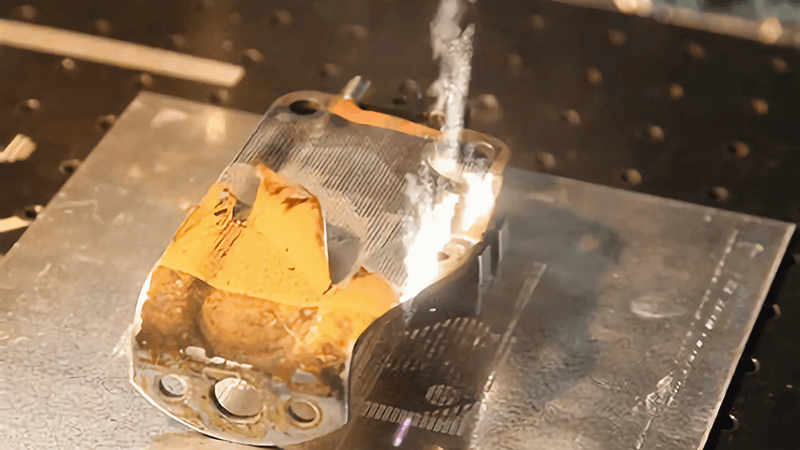Laser cleaning sounds powerful, but many people worry it might hurt the metal itself. This fear often stops companies from adopting it, even though it's one of the cleanest and most precise technologies available today.
Laser cleaning does not damage metal surfaces when applied correctly. It uses controlled laser energy to remove rust, paint, and contaminants without physical contact. The base metal remains intact, making it an ideal solution for industries like automotive, aerospace, and manufacturing.
Many of our clients at Kirin Laser ask this question before switching from traditional sandblasting or chemical cleaning. In this article, I will explain how laser cleaning works, why it is safe, and how it protects metal integrity in real-world applications.

How do lasers clean metal?
Laser cleaning might look complex, but the concept is simple. Many people think it “burns” the surface. That’s not true. The laser targets only the unwanted layers, leaving the base metal clean and untouched.
Lasers clean metal by directing focused energy pulses onto the surface, causing rust, paint, or oil to evaporate or separate without mechanical contact. The beam interacts with the contaminants, not the metal, making the process clean and precise.
How the process works
Laser cleaning1 relies on physical and thermal effects, not chemicals or abrasives. Here’s a closer look at the mechanism:
| Step | Action | Effect on Surface |
|---|---|---|
| 1 | Laser beam is directed at the surface | Energy is absorbed by contaminants |
| 2 | Contaminants heat up quickly | Layers evaporate or peel away |
| 3 | Base metal reflects most laser energy | Metal stays cool and unharmed |
| 4 | Scanning continues until surface is clean | Clean surface achieved without abrasion |
Controlled energy input
At Kirin Laser2, we fine-tune parameters like:
- Laser power: Determines how much energy is delivered
- Pulse frequency: Controls the precision of each shot
- Scanning speed: Affects how long the beam stays on each spot
This level of control allows us to clean everything from delicate aluminum molds to heavy steel components with the same machine, just by adjusting settings.
Real-world application
A client in the automotive sector used our laser cleaning machine to remove rust from steel molds. Traditional sandblasting was damaging the edges of the molds and causing frequent downtime. By switching to laser cleaning, they removed the rust layer precisely, avoided base metal wear, and extended the life of their molds significantly.

How safe is laser cleaning?
Many people assume that laser cleaning involves extreme heat and could harm surfaces or operators. The reality is quite different. When operated correctly, laser cleaning is one of the safest surface treatment methods available.
Laser cleaning is safe for both operators and metal surfaces because it is a non-contact, controllable process that uses specific wavelengths to target contaminants only. It avoids chemicals, reduces waste, and minimizes operator exposure to hazardous materials.
Why laser cleaning is safer than traditional methods
| Method | Safety for Operators | Environmental Impact | Risk to Metal |
|---|---|---|---|
| Sandblasting | Requires heavy PPE | Dust and waste generation | Can erode surfaces |
| Chemical cleaning | Exposure to toxic agents | Hazardous disposal needed | Can cause corrosion |
| Laser cleaning | Minimal PPE, non-contact | Clean and dry process | No damage when controlled |
Built-in safety systems
Kirin Laser machines are equipped with:
- Safety interlocks3 to prevent accidental exposure
- Fume extraction systems to remove vaporized contaminants
- Laser shields and goggles to protect operators
These features ensure that even high-power systems can be used in production environments safely.
Process stability
Laser cleaning4 uses precise software control. Once parameters are set for a specific material, the process repeats consistently. This removes the variability that often leads to accidental damage in manual methods like grinding or chemical dipping.

Is laser cleaning abrasive?
This is one of the biggest misconceptions. People often compare laser cleaning to sandblasting because both remove rust and coatings. But their mechanisms are fundamentally different.
Laser cleaning is non-abrasive. It removes layers without physical impact or erosion. The laser does not scrape or wear away the base metal, making it ideal for delicate surfaces and high-precision parts.
Comparing abrasive and non-abrasive methods
| Feature | Sandblasting | Laser Cleaning5 |
|---|---|---|
| Contact | Physical impact with abrasive media | No physical contact |
| Surface wear | High, especially on soft metals | None when tuned properly |
| Precision | Limited, depends on operator | High, software-controlled |
| Cleanliness | May leave media residue | Leaves clean, residue-free surface |
Why non-abrasive matters
In industries like aerospace and automotive, even small changes to surface geometry can affect performance. For example, damaging the tolerance of a steel mold by 0.1 mm can ruin production alignment. Laser cleaning avoids this risk completely.
My experience
I once visited a factory using sandblasting6 for delicate aluminum molds. Over time, they noticed edge rounding and micro scratches that affected sealing performance. After they switched to our laser cleaning system, these problems disappeared. The molds stayed intact, and the cleaning time was cut in half.

Does laser cleaning damage metal?
This is the core question, and the answer is clear. When applied correctly, laser cleaning does not damage metal surfaces. The energy is absorbed by contaminants, not the base metal. The key is using the right parameters for the specific application.
Laser cleaning preserves metal integrity by removing only surface contaminants. It uses precise control to avoid overheating, melting, or altering the base material.
Why laser cleaning protects metal
| Factor | Traditional Methods | Laser Cleaning7 |
|---|---|---|
| Heat distribution | Uneven, often overheats surface | Controlled and localized |
| Mechanical stress | High, causes scratches or dents | None |
| Surface integrity8 | May degrade over time | Preserved, even after multiple cleanings |
Parameter optimization
At Kirin Laser, we test and calibrate machines before delivery. We work with customers to define:
- Optimal laser power for each material
- Suitable pulse frequency to avoid heat accumulation
- Correct scanning speed for balanced cleaning
Once set, these parameters ensure stable, repeatable cleaning without affecting the metal structure.
Long-term effects
Repeated cleaning with abrasive methods can wear away surface layers over time. Laser cleaning, on the other hand, can be repeated hundreds of times with no measurable loss of material. This makes it especially useful for expensive molds, dies, and components that need regular maintenance.
A client story
An automotive parts manufacturer struggled with rust on their steel molds. Chemical cleaning caused pitting, and sandblasting damaged the surface finish. After switching to our laser cleaning machine, they cleaned hundreds of molds without a single incident of damage. Their maintenance costs dropped, and mold life increased significantly.

Conclusion
Laser cleaning9 is not only safe but also the most precise, non-abrasive way to clean metal surfaces. It removes contaminants like rust, paint, and oil without damaging the base metal. By controlling power, frequency, and speed, we can clean delicate or heavy components with equal effectiveness. At Kirin Laser, we see this technology transform industries, making maintenance cleaner, safer, and more efficient. For companies that want to protect their assets while keeping them in perfect condition, laser cleaning is the future.
-
Explore the advantages of laser cleaning technology for efficient and safe surface treatment. ↩
-
Discover the range of laser cleaning services provided by Kirin Laser for various applications. ↩
-
Learn about safety interlocks and how they enhance operator safety in laser cleaning processes. ↩
-
Explore how laser cleaning minimizes risks for operators and the environment, making it a superior choice. ↩
-
Explore the advantages of Laser Cleaning to understand its impact on precision and surface integrity in various industries. ↩
-
Learn about the limitations of sandblasting to see why non-abrasive methods like laser cleaning are often preferred. ↩
-
Explore the advantages of laser cleaning, including its efficiency and preservation of metal integrity. ↩
-
Understanding surface integrity is crucial for selecting the right cleaning method to maintain metal quality. ↩
-
FInding the best laser cleaning machine and laser cleaning solutions from Kirin Laser, clicking this link to get all your needs for your business. ↩





